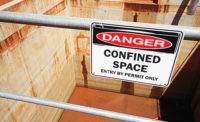I wrote a similar article on this subject in 2005 for this magazine. To quote the third sentence of that article, “Confined Space Entry is a leading cause of occupational fatalities within the United States!” Every year, more articles are generated on this subject. And, to what avail? I read a quote this week that stated confined spaces are still the leading cause of multiple fatalities in the workplace.
There are only two programs that I believe require repeated discussions because failure to do things right in either of them can lead to death. Those programs are LOTO and Confined Space Entry.
LOTO was put in place because people kept (and keep) dying from exposure to energized equipment. Confined Space Entry exists because people kept (and keep) dying from exposure to known, existing hazards that cause death.
I am not a vendor and I’m not selling you the next scientific breakthrough in confined space equipment. If it exists, go check it out. I am a 40-plus-year, now retired, safety professional that is grateful to get to the end with no one being fatally injured on my watch. I attribute much of that to mostly working for companies with leadership that actually wanted a safe culture. The rest I attribute to keeping things simple – focus on what gets people injured or killed and how their decisions directly impact their own quality of life, going forward.
The purpose of a confined space permit is that there is a confined space, it requires someone entering it to perform work, and there is at least one known hazard that, left unaddressed, may kill the entrant. In other words, if it can kill you, it likely needs a permit.
What is a ‘Confined Space’?
I never understood the confusion over this definition. A confined space has three components: it must have a limited ingress/egress, it must be large enough for a body to fit in it to perform work; it must not be designed for continuous occupancy to work in the space. Let’s break this down for just a moment.
- Limited ingress/egress - often means only one way in and the same way back out;
- Large enough for a body to fit in the space – at least 18” wide and capable of getting inside;
- Not designed for occupancy – no HVAC, ventilation, temperature controls, etc.
If you have a container that you can only fit a hand inside to turn a dial, it is NOT a confined space. If you have a shop office inside of a maintenance hangar with only one door in/out but it has HVAC because you work in it all day, it is not a confined space. If you have at least two ingress/egress points that remain clear and accessible with an ability to quickly leave an area, it is likely not a confined space.
All three criteria in the definition of a confined space must be “true” to have a confined space. Get rid of one of the three, there is no confined space!
What is a ‘Permit-Required Confined Space’?
First, it must meet the definition of a confined space. Next, there must be the potential of only one life-threatening hazard in the space to require a permit. OSHA states (paraphrased):
- Atmospheric hazard – something in the air that potentially is oxygen-deplete or oxygen-enriched, flammable/explosive, or toxic (poisonous);
- Potential for engulfment, entrapment, or drowning;
- A physical hazard, such as temperature extreme(s), noise, unguarded machinery;
- Or “other” for any hazard that you might think of that could still kill you but not listed above.
All entrants, attendants, and authorizing supervisors must be aware of the hazards (knowledge), must know how to address the hazards (trained), and must ensure a rescue plan exists to extract entrants who get in trouble.
A permit application must be completed by the entrant(s) to enter a permit-required confined space. This process ensures the entrant is aware of the hazards, can be protected from the hazards, and that someone can perform a rescue if something goes wrong.
An “authorizing supervisor” is legally the person who has checked the permit application, ensures all corrective measures are in place, and assigns a dedicated “attendant” whose role is to ensure all entrants remain alive while in the confined space.
The attendant is the communication link with the entrant, not the rescuer. Most fatalities related to confined space are “would-be rescuers,” generally the attendant that has no training or equipment to perform the rescue and dies in that attempt.
If you need more information, a simple web search will get you hundreds to thousands of hits for help. Today, we just want to go back to the fundamental basics of confined spaces and deliver a simple message that will end confusion and prevent a fatality.



